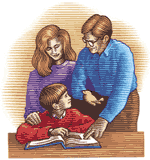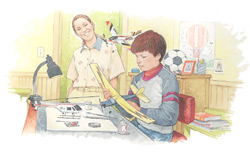![]() October 1999
October 1999

By Diana Lynn
Illustration by Joel Snyder

"Slow down!" my friend called to her son as he ran across the park. "You put your boots on the wrong feet!"
Nathan, her 6-year-old, screeched to a halt, switched boots, then ran off again alongside my son. Nathan's gait was now smooth and flowing, but my son was still running puppy-style, as if he had put his shoes on the wrong feet.
My heart sank. At their age, I had read and played with dolls while my friends jumped rope, rode bikes, and skated - all activities I still can't do. In college, I spent all day playing eight holes of golf for a final exam score of 400 - no doubt a world's record. The coach offered me a passing grade if I promised never to take another class from him. He may have been joking, but it wasn't funny to me. By all accounts, clumsiness runs on one side of my family, and now I wondered if my son faced the same awkward future.
Experts don't agree about what causes marked clumsiness. While none considers it genetic, it still shows up across generations in families like mine. While a few experts insist it is modeled behavior, passed down by following the cues of ungraceful parents, others point to a variety of causes and conditions, among them:
Many adults may think a child will outgrow this clumsy phase; a few may even send him or her to the sidelines with little sympathy.
Neither of these approaches is helpful, because, no matter what the cause, parents should have all poorly coordinated children examined by a pediatrician to rule out physical disorders, disease, or brain damage. Some clumsy children may also have learning disorders, behavior problems, language difficulties, or accident-proneness. It's crucial to get any of these problems diagnosed and addressed as soon as possible.
But what if the medical and developmental tests come back negative, and your child's clumsiness persists beyond simple growth spurts and during what appear to be easy, routine tasks?
In other words, what if your child is simply uncoordinated?
For the majority of children with marked clumsiness, working with an occupational therapist (O.T.) is perhaps the best answer.
O.T.'s train children's motor skills, monitor each child's individual progress, and offer activities to be done at home with parents and other adults. They also help parents understand and appreciate the difficulties their children may be experiencing as well as educate them about normal and abnormal motor development.
Coordination isn't a single skill. It's made up of multiple factors, such as visual perception, hearing, spatial awareness, directionality, muscle tone, motor memory, balance, motivation, concentration, etc., all working together at the same time. O.T.'s find those particular areas that are out of tune in a child and then specifically address them.
A well-designed occupational therapy program slowly builds a child's coordination while increasing self-confidence. The idea is to gradually challenge and help a child in a way that is still fun. For example, dominoes and puzzles improve perceptual skills. Arm-wrestling and tug-of-war build muscle strength. Playing kickball and jumping rope develop hand-eye-foot coordination.
Uncoordinated kids may need their self-esteem built up by their parents at home in order to survive inevitably embarrassing days at school. Awkward adults can avoid activities they can't easily perform, but clumsy children don't have that freedom. School can become a string of embarrassing events that leads to social isolation and even bad behavior, but home should be the safe place where motor skills are slowly and patiently developed.
San Diego teacher and educational therapist Giza Braun advises parents to "Let your child know we all have strengths and weaknesses, and acknowledge your own weaknesses. At the same time, always help your child identify with his strengths, not his weaknesses. Say something like, 'Yes, soccer was really hard for you today, but not everyone can make scale models like you can.'"
Parents need to give a message to every child (uncoordinated or not) that he or she is good at something and has a special gift or talent.
This does not mean allowing an awkward child to burrow into these pastimes to the exclusion of all physical activity. Look for interests in physical activities that don't require a high level of motor competence, such as music, gardening, photography, sewing, cooking, collecting, caring for pets, swimming, fishing, and so on, and then support these interests.
Leisure activities by definition need to be enjoyable. Overly challenging sports should not be forced on clumsy children in the belief that it will help their poor motor development. Giza Braun suggests parents find alternative group athletic activities for these children, such as martial arts and backpacking.
When concerned parents seek advice from school staff or family doctors, they are often told to wait and see, that their child will outgrow it. Braun suggests parents should not wait. "It's always good to get an evaluation if you sense something's wrong. It may turn out to be nothing, but then you'll know."
An expert in childhood clumsiness, Dr. Kathy Ahern of Edith Cowan University in Perth, Australia, tells parents to keep looking until they find a professional who knows the signs and symptoms of clumsiness and also knows what clumsiness leads to in terms of psychosocial problems.
Children try to hide their poor motor coordination. Some become loners. Some find excuses: "It's too hot; it's too cold; I've got a tummy ache." Others become bullies. All will try to adapt to their clumsiness, and the adults in their lives can make the difference between a negative adaptation or a positive one.
Occupational therapist Susan Smyth of Eureka, Calif., who has spent 30 years helping children with poor motor coordination, notes just how challenging life is for the clumsy child. These children, she says, feel generalized uneasiness about their bodies in space all the time. This makes them tense on the inside, even though they may appear lethargic, and it uses up extra energy. They expend even more energy thinking and planning their movements, since they often cannot move around automatically. They need our understanding and patience.
Smyth remembers a 7-year-old boy who spent every recess walking around and around the edge of the school playground. His motor skills were those of a 2-year-old. After one year of working with Smyth, developing a foundation of basic skills, he joined his schoolmates in kickball and four square. He didn't play organized sports, she reports, but he had a great time playing ball.
Fortunately, an O.T. helped my son, too. He never became a star athlete, but neither did he spend recess on the sidelines as I had. He's a college student now who backpacks, ballroom dances, and practices the martial arts of Aikido and Wa Rang Do all with his shoes definitely on the right feet. S
Diana Lynn is a freelance writer in Bayside, Calif.
Federal Law Guarantees Help to FamiliesIf you suspect your child is not developing as his or her peers and may have a coordination disorder, write a letter to your school principal requesting an evaluation. If you can, describe the suspected disability and how it affects performance in school. Keep a copy of the letter. Your school should complete an evaluation of your child in a timely manner and with qualified personnel. Ask for someone with specialized sensorimotor training. If your requests are not met, contact your state department of education. The federal law that authorizes this free evaluation is the Individuals With Disabilities Education Act, mandating a free and appropriate education for all children (ages 3 to 21) with disabilities. |
Clumsiness DefinedPsychologists and psychiatrists call clumsiness Developmental Coordination Disorder, while occupational therapists call it Apraxia or Motor Impairment. It is also referred to as Clumsy Child Syndrome, Perceptuo-motor Dysfunction, Motor Learning Difficulty, or Sensory Integrative Disorder. For most children there is no known cause, although it is thought to be an immaturity of neuron development in the brain rather than brain damage. Apraxic children have no clinical neurological abnormality to explain their condition. These names all refer to the same childhood clumsiness that stops normal children from carrying out the ordinary activities of daily living due to an impairment or immaturity in the way they organize movement. Because marked clumsiness can also include problems with language, perception, or thought, parents should also look closely at or consider a child's:
|
Books and ResourcesWatch Me, I Can Do It: Helping Children Overcome Clumsy and Uncoordinated Motor Skills by Neralie Cocks (Simon & Schuster, 1998). Describes normal stages of motor development, factors that influence coordination, and gives hands-on instructions to help clumsy children improve. Sensibilities: Understanding Sensory Integration by Maryann Colby Trott (Therapy Skill Builders, 1993). For parents and teachers who are helping children, with practical suggestions and clear explanations. Clumsy Child Syndromes: Descriptions, Evaluation and Remediation by Bryant J. Cratty (Harwood Academic Publishers, 1993). For medical and paramedical practitioners; about poorly coordinated children. |
| The Boy Scouts of America | http://www.scouting.org |